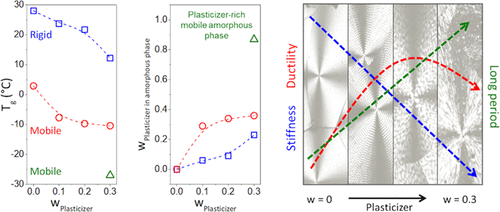Our official English website, www.x-mol.net, welcomes your feedback! (Note: you will need to create a separate account there.)
Plasticization of Poly(3-hydroxybutyrate-co-3-hydroxyvalerate) with an Oligomeric Polyester: Miscibility and Effect of the Microstructure and Plasticizer Distribution on Thermal and Mechanical Properties
ACS Omega ( IF 4.1 ) Pub Date : 2021-01-21 , DOI: 10.1021/acsomega.0c05765 Jacqueline L. Barbosa 1 , Giovanni B. Perin 1 , Maria Isabel Felisberti 1
ACS Omega ( IF 4.1 ) Pub Date : 2021-01-21 , DOI: 10.1021/acsomega.0c05765 Jacqueline L. Barbosa 1 , Giovanni B. Perin 1 , Maria Isabel Felisberti 1
Affiliation

|
In the last few decades, many efforts have been made to make poly(3-hydroxybutyrate) (PHB) and its copolymers more suitable for industrial production and large-scale use. Plasticization, especially using biodegradable oligomeric plasticizers, has been one of the strategies for this purpose. However, PHB and its copolymers generally present low miscibility with plasticizers. An understanding of the plasticizer distribution between the mobile and rigid amorphous phases and how this influences thermal, mechanical, and morphological properties remains a challenge. Herein, formulations of poly(hydroxybutyrate-co-valerate) (PHBV) plasticized with an oligomeric polyester based on lactic acid, adipic acid, and 1,2-propanediol (PLAP) were prepared by melt extrusion. The effects of the PLAP content on the processability, miscibility, and microstructure of the semicrystalline PHBV and on the thermal, morphological, and mechanical properties of the formulations were investigated. The compositions of the mobile and rigid amorphous phases of the PHBV/PLAP formulations were easily estimated by combining dynamic mechanical data and the Fox equation, which showed a heterogeneous distribution of PLAP in these two phases. An increase in the PLAP mass fraction in the formulations led to progressive changes in the composition of the amorphous phases, an increase of both crystalline lamellae and interlamellar layer thickness, and a decrease in the melting and glass transition temperatures as well as the PHBV stiffness. The Flory–Huggins interaction parameter varied with the formulation composition in the range of −0.299 to −0.081. The critical PLAP mass fraction of 0.37 obtained from thermodynamic data is close to the value estimated from dynamic mechanical analysis (DMA) data and the Fox equation. The mechanical properties showed a close relationship with the distribution of PLAP in the rigid and mobile amorphous phases as well as with the microstructure of the crystalline phase of PHBV in the formulations.
中文翻译:

聚(3-羟基丁酸酯的增塑共聚相容性和对热和机械性能的显微结构和增塑剂分布效果:与低聚聚酯-3-羟基戊酸酯)
在过去的几十年中,已经做出了许多努力以使聚(3-羟基丁酸酯)(PHB)及其共聚物更适合于工业生产和大规模使用。增塑,特别是使用可生物降解的低聚增塑剂,已成为实现此目的的策略之一。但是,PHB及其共聚物通常与增塑剂的混溶性较低。对流动相和刚性无定形相之间的增塑剂分布及其对热,机械和形态性能的影响的理解仍然是一个挑战。本文中,聚(羟基丁酸酯-co通过熔融挤出制备基于乳酸,己二酸和1,2-丙二醇(PLAP)的低聚聚酯增塑的-戊酸酯(PHBV)。研究了PLAP含量对半结晶PHBV的可加工性,可混溶性和微结构以及制剂的热,形态和机械性能的影响。通过将动态力学数据和Fox方程相结合,可以轻松估算PHBV / PLAP配方的流动相和刚性非晶相的组成,这表明PLAP在这两个相中分布不均。制剂中PLAP质量分数的增加导致非晶相组成的逐渐变化,结晶层和层间层厚度均增加,熔融和玻璃化转变温度以及PHBV刚度的降低。Flory-Huggins相互作用参数随配方组成在-0.299至-0.081范围内变化。从热力学数据获得的临界PLAP质量分数为0.37,接近于根据动态力学分析(DMA)数据和Fox方程估算的值。力学性能显示与PLAP在刚性和移动无定形相中的分布以及配方中PHBV结晶相的微观结构密切相关。从热力学数据获得的37接近于从动态力学分析(DMA)数据和Fox方程估算的值。力学性能显示与PLAP在刚性和移动无定形相中的分布以及配方中PHBV结晶相的微观结构密切相关。从热力学数据获得的37接近于从动态力学分析(DMA)数据和Fox方程估算的值。力学性能显示与PLAP在刚性和移动无定形相中的分布以及配方中PHBV结晶相的微观结构密切相关。
更新日期:2021-02-02
中文翻译:

聚(3-羟基丁酸酯的增塑共聚相容性和对热和机械性能的显微结构和增塑剂分布效果:与低聚聚酯-3-羟基戊酸酯)
在过去的几十年中,已经做出了许多努力以使聚(3-羟基丁酸酯)(PHB)及其共聚物更适合于工业生产和大规模使用。增塑,特别是使用可生物降解的低聚增塑剂,已成为实现此目的的策略之一。但是,PHB及其共聚物通常与增塑剂的混溶性较低。对流动相和刚性无定形相之间的增塑剂分布及其对热,机械和形态性能的影响的理解仍然是一个挑战。本文中,聚(羟基丁酸酯-co通过熔融挤出制备基于乳酸,己二酸和1,2-丙二醇(PLAP)的低聚聚酯增塑的-戊酸酯(PHBV)。研究了PLAP含量对半结晶PHBV的可加工性,可混溶性和微结构以及制剂的热,形态和机械性能的影响。通过将动态力学数据和Fox方程相结合,可以轻松估算PHBV / PLAP配方的流动相和刚性非晶相的组成,这表明PLAP在这两个相中分布不均。制剂中PLAP质量分数的增加导致非晶相组成的逐渐变化,结晶层和层间层厚度均增加,熔融和玻璃化转变温度以及PHBV刚度的降低。Flory-Huggins相互作用参数随配方组成在-0.299至-0.081范围内变化。从热力学数据获得的临界PLAP质量分数为0.37,接近于根据动态力学分析(DMA)数据和Fox方程估算的值。力学性能显示与PLAP在刚性和移动无定形相中的分布以及配方中PHBV结晶相的微观结构密切相关。从热力学数据获得的37接近于从动态力学分析(DMA)数据和Fox方程估算的值。力学性能显示与PLAP在刚性和移动无定形相中的分布以及配方中PHBV结晶相的微观结构密切相关。从热力学数据获得的37接近于从动态力学分析(DMA)数据和Fox方程估算的值。力学性能显示与PLAP在刚性和移动无定形相中的分布以及配方中PHBV结晶相的微观结构密切相关。


























 京公网安备 11010802027423号
京公网安备 11010802027423号